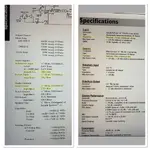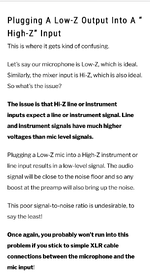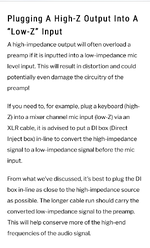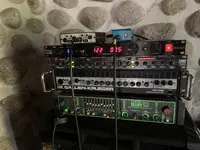It's so easy to misunderstand how AC circuits work. Even for those who did physics at school, it usually boils down to Ohms Law - and we worry about voltages, resistance and currents and making circuits. They deliberately don't go into AC circuits because then resistance becomes impedance and there's a big step up in the things that impact on AC - so inductance, capacitance and resonance suddenly creep in. Teachers of the subject have to take a deep breath before leaping in, because misunderstanding is so easy, and when non-teachers who do understand it try to explain it they fail, and those that haven't quite got it (like in those examples above) fail miserably. In fact, when you get it right, you can squirt audio down extremely long lengths of cable with decent results. Mic wise - we all kind of take 150-600Ohms or so as 'normal' for mics - but back in the 60's/70's we had high impedance versions or switchable ones) so you could plug a mic into a jack on a guitar amp. Many also forget that at this period we also had some mics in very low impedance versions - 25-50 Ohms.
The reality of connecting devices is to get the matching as equal as you can, with the source impedance always being lower than the impedance of the destination. Optimum level matching without unwanted loss of HF. Cable has capacitance, especially in longer lengths, and this is what generates the old rule about high impedance guitar pickups and shorter cables. Look at a typical guitar tone control. What exactly is it? A single capacitor, wired through a variable resistance across the pickup output. What does it do? It reduces the level of the higher frequencies. If you change the capacitor value, it just alters where the cut begins and how sharp that cut is. If you wanted to, you could use two knobs and a little inductor and have a treble and a bass roll off. Anyway - if a little capacitor can make the bright pickup become mellow, then a long length of cable that has capacitance does exactly the same thing. If you look up the specification of cables it tells you the capacitance per foot or metre.
If you get the source and destination impedance around the wrong way - as in connecting a piezo pickup to a mic input, the effect is of putting a virtual short-circuit on the very high impedance - so level drops quite a bit, but then you restore it with the gain control and that is where the noise comes from. This near short on a wirewound pickup also deadens the strings. You've played with magnets and how they can push against each other - and a coil, partially shorted, tries to limit the forward and backward voltage the string is inducing in it - kind of putting the brakes on. If you twang a guitar with good sustain with the guitar unplugged, you can time how long it takes to decay. If you short a jack plug and stick it in, the sustain time goes down. Not much, but at college we measured it and proved the science.With modern DAWs, you can edit the twang start and end to a pretty accurate level - say -3dB and trim the clip start. Then find a very low point you can measure and trim again. If you do the short and trim that one - to the same levels, you'll find it's not the same length - it decays quicker.





